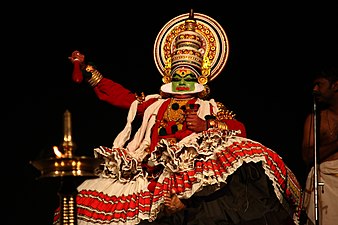Kathakali
Kathakali (Malayalam: കഥകളി) is a major form of classical Indian dance.[1] It is a "story play" genre of art, but one distinguished by the elaborately colourful make-up, costumes and face masks that the traditionally male actor-dancers wear.[2][3][note 1] It is native to the Malayalam-speaking southwestern region of Kerala and is almost entirely practiced and appreciated by Malayali people.[2][3][5]

Kathakali's roots are unclear. The fully developed style of Kathakali originated around the 17th century, but its roots are in the temple and folk arts (such as Krishnanattam and religious drama of the kingdom of the Zamorin of Calicut) southwestern Indian peninsula), which are traceable to at least the 1st millennium CE.[2][6] A Kathakali performance, like all classical dance arts of India, synthesizes music, vocal performers, choreography and hand and facial gestures together to express ideas. However, Kathakali differs in that it also incorporates movements from ancient Indian martial arts and athletic traditions of South India.[2][3][5] Kathakali also differs in that the structure and details of its art form developed in the courts and theatres of Hindu principalities, unlike other classical Indian dances which primarily developed in Hindu temples and monastic schools.
The traditional themes of the Kathakali are folk stories, religious legends and spiritual ideas from the Hindu epics and the Puranas.[7] The vocal performance has traditionally been performed in Sanskritised Malayalam.[6] In modern compositions, Indian Kathakali troupes have included women artistes,[4] and adapted Western stories and plays such as those by Shakespeare.[8]
History
Elements and aspects of Kathakali are taken from ancient Sanskrit texts such as the Natya Shastra.[11] The kathakali is attributed to sage Bharata, and its first complete compilation is dated to between 200 BCE and 200 CE,[12][13] but estimates vary between 500 BCE and 500 CE.[14]The most studied version of the Natya Shastra text consists of about 6000 verses structured into 36 chapters.[12][15] The text, states Natalia Lidova, describes the theory of Tāṇḍava dance (Shiva), the theory of rasa, of bhāva, expression, gestures, acting techniques, basic steps, standing postures–all of which are part of Indian classical dances including Kathakali.[11][12][16] Dance and performance arts, states this ancient Hindu text,[17] are a form of expression of spiritual ideas, virtues and the essence of scriptures.[18]The roots of Kathakali are unclear. Jones and Ryan state it is more than 500 years old. Kathakali emerged as a distinct genre of performance art during the 16th and 17th centuries in Kerala.[19] The roots of Kathakali, states Mahinder Singh, are more ancient and some 1500 years old.[20]